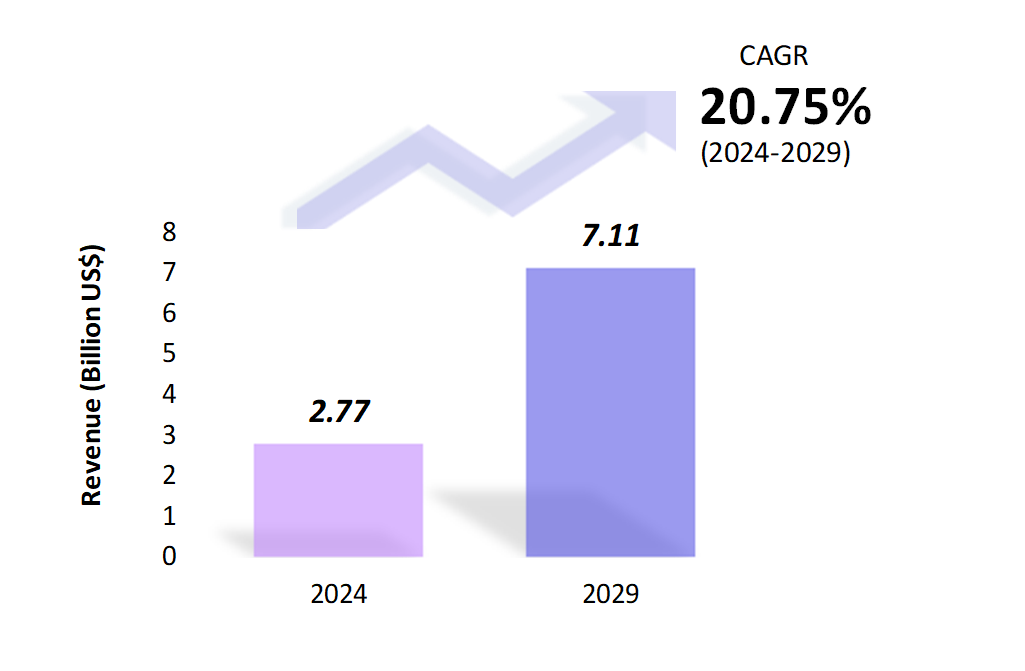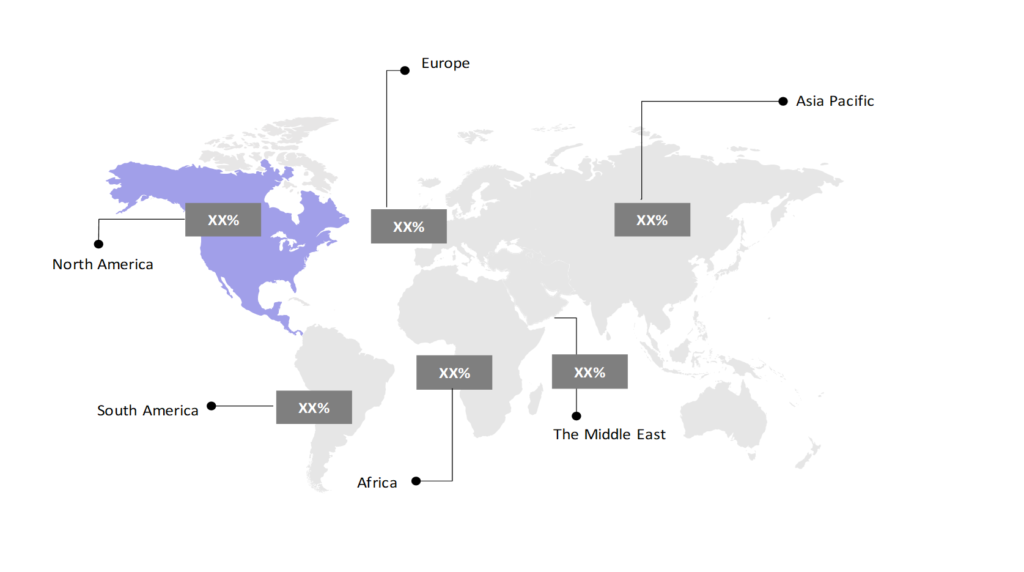3D Printing Plastics Market Outlook: Size, Share, Trends & Growth Analysis (2024-2029)
The report covers a comprehensive analysis segmented by Type (Photopolymer, ABS, Polyamide, PLA, PETG), By Form (Powder, Filament, Liquid), By Application (Prototyping, Manufacturing, Tooling), By End User (Healthcare, Aerospace & Defense, Automotive, Consumer Goods, Others), By Geography (North America, Latin America, Asia Pacific, Europe, The Middle East)
3D Printing Plastics Market Snapshot

3D Printing Plastics Market Overview
The projected value of the global market for plastics produced through 3D printing is $2.77 billion in 2024 and is expected to rise to $7.11 billion in 2029. Between 2024 and 2029, the global market for polymers used in 3D printing is expected to grow at a compound annual growth rate (CAGR) of 20.75%. The advancements in its technology over the years contributed to the development of various methods and materials used in 3D printing. Healthcare and aerospace sectors have stringent regulations and safety standards. Additionally, they are using this technology to produce items like medical implants and intricate yet lightweight components, which boosts the demand for 3D printing technology.
3D Printing Plastics Market Coverage
| Historical & Forecast Period | 2018-2029 |
| Base Year | 2023 |
| Forecast Period | 2024-2029 |
| Units | Billion US$ |
| Segments | Type, Form, Application, End User |
| Geographies | North America, South America, Asia Pacific, Europe & Middle East, Africa |
| Key Vendors | 3D Systems, Inc., Evonik Industries AG., BASF SE, Stratasys Ltd., Henkel Corp. |
Key Geographies of 3D Printing Plastics Market, 2023

Porter’s 5 Forces Analysis of 3D Printing Plastics Market

3D Printing Plastics Market Trends
The bargaining power of the buyer in this market remains moderate. 3D printed materials have gained popularity in the healthcare sector and the automotive industry. The recent development in the creation of Bone-like substance that consists of hydroxyapatite, a calcium phosphate, the main mineral component of natural bone using 3D print can further popularize its use in the health sector. Distinctive optical characteristics may be important in the shift to renewable energy and industry. The growing need for spare parts has also aided the popularity of 3D printed parts due to the increasing number of devices and automobiles.
3D Printing Plastics Market Driving Factors
The applications of 3D printing plastics are significantly expanding with technological advancements, with the help of which greater accuracy, precision, and speed of production is achieved with lesser production cost. The sufficient supply of 3D printing materials like polymer and plastics further aids in the growing usage of this technology. The potential of 3D printing technology to expedite product development and enable rapid prototyping has fueled the market’s expansion in many industries, including consumer goods, automotive, healthcare, and aerospace. Since this technology allows the convenience of customization, it proves to be extremely useful in the healthcare sector.
Prosthetics can be designed and customized to precisely match a patient’s requirement. The compatibility of 3D printing machines with various materials also contributes significantly to their popularity. The use of 3D printing technology for producing architectural models and scale models is also gaining popularity amongst people. Government initiatives worldwide also promote substantial investments in advanced manufacturing, research, and development. These aid in its demand across various sectors. Growing competition in manufacturing is also causing businesses to invest in their R&D as the growing culture of startups looks forward to fast and economically feasible techniques that assist in cost-effective production along with the convenience of customization, allowing businesses to become more creative and allowing them to grow at a faster pace.
3D Printing Plastics Market Challenges
The excessive cost of 3D printing machines, along with their installation, becomes a challenge and an obstacle in the widespread adoption of 3D printing technology. Materials for 3D printing integrate various features for sole use. Because these materials have qualities like strength, flexibility, and heat resistance, it becomes challenging. These materials require costly processing to be ready for 3D printing. The high production cost of three-dimensional printing techniques deter its growth in the market. Moreover, since plastics are one of the critical materials used in 3D printing technology, the growing environmental concern over pollution due to the increased use of plastics and improper disposal of plastic materials hinders its market growth. The amount of time needed to train those who will be producing goods with this technology is another significant obstacle. Some sectors, like healthcare and aerospace, are regulated by various governments across the globe. They must be met along with strict quality and safety standards. Obtaining certifications and licenses can be a cumbersome process for businesses looking forward to adopting this technology. The manufacturing process of 3D printing plastics and hi-tech machinery lacks standardization. The 3D printing plastic manufacturing processes are mostly automated,, leading to skepticism amongst people regarding accuracy and reduced manual labor,, thereby hampering its growth in the market.
3D Printing Plastics Market – Key Industry News
- In February 2024, Tri-Tech 3D, A UK-based provider of Stratasys 3D printing solutions, introduced TrueDent resin for 3D printing. This resin removes the need to bond teeth to the gingiva, thereby simplifying the work of dental laboratories.
- In September 2023, 3D-printed plasmonic plastic enabled the production of optical sensors. Researchers at Chalmers University of Technology in Sweden developed unique optical properties that could play a significant role in the transition to green energy and industry.
- In July 2022, the first commercially available 3D-printed bone-like implants were provided by Cerhum, a medical device company in Liege, Belgium. It enhances the ability to customize and design implants to precisely match the requirements of patients, thereby allowing Cerham to expand its portfolio into the dental and oncological market.
3D Printing Plastics Market Competitive Landscape
The 3D printing plastics market is concentrated due to the moderate number of sellers. The report includes an analysis of the major companies involved within the global 3D printing plastics industry, considering recent developments and news of companies involved in the market. The global 3D printing plastics industry participants are always developing strategies to maintain a competitive advantage.
Companies primarily use acquisitions, R&D, partnerships, technological launches, and other tactics to offer more efficient 3D printing plastic solutions. This allows the market players to hold a strong position in the upcoming market competition. Innovations and increased investments are assisting in its market growth. Several essential entities in the 3D printing plastics market include 3D Systems, Inc., Evonik Industries AG., BASF SE, Stratasys Ltd., and Henkel Corporation.
3D Printing Plastics Market – Key Companies

Reason to Buy from us

Table of Contents
| 1. Introduction |
|
| 2. Market Overview / Executive Summary |
|
| 3. Market Segmentation |
|
| 4. Regional Segmentation |
|
| 5. Value Chain Analysis of the Global 3D Printing Plastics Market | |
| 6. Porter Five Forces Analysis |
|
| 7. Trends, Drivers and Challenges Analysis |
|
| 8. Regulatory Landscape | |
| 9. Competitive Landscape |
|
3D Printing Plastics Market – Frequently Asked Questions (FAQs)
What is the current size of the global 3d printing plastics market?
The market size for the global 3d printing plastics market in 2024 is $2.77 Bn.
Who are the major vendors in the global 3d printing plastics market?
The major vendors in the global 3D printing plastics market are 3D Systems, Inc., Evonik Industries AG., BASF SE, Stratasys Ltd., and Henkel Corp.
Which segments are covered under the global 3d printing plastics market segments analysis?
This report offers in-depth insights into each type, form, application, end user.
